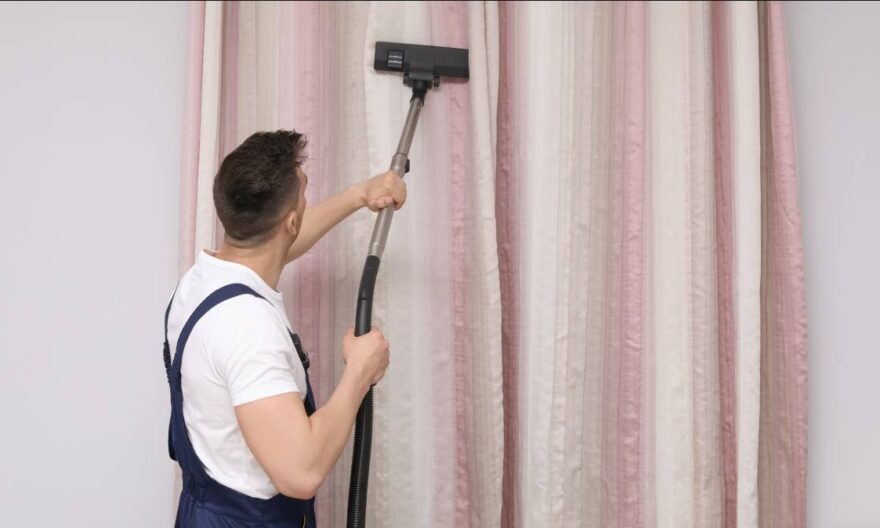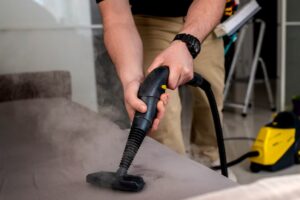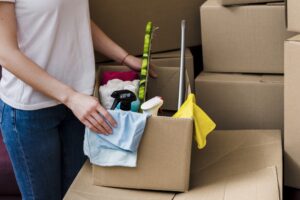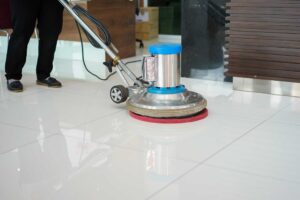
The general high humidity and warm temperature of the tropical setting in Singapore provide a site for these molds and mildew to multiply. These unwelcome guests can also grow on the household, like curtains, leaving unsightly stains and producing musty odors. Besides being ugly, these pests are smart, and they may be harmful to health—for example, allergies and respiratory problems that may be caused by mold and mildew.
So, you noticed some mold or mildew on your curtain—no cause for alarm. The fact to act on now is that it has to be taken off as soon as possible; however, the good news is that some help can come from DIY solutions to revive your curtains. But first, safety—before carrying out any curtain cleaning Singapore.
Essential Preparations for Safe Cleaning
Spores of mold and mildew can aggravate respiratory and skin conditions. Protection should be geared up before taking up this cleaning task. Wear rubber gloves to protect your hands from the spores. Also, consider wearing a mask since airborne spores can set off a risk of inhalation, most especially when a person is allergic or has respiratory sensitivity.
After you have your safety gear on, then prepare all the cleaning equipment that you might need. This may include a soft-bristle brush to help remove most surface mold and mildew spores. This can be a spray bottle that you have to mist the chosen cleaning solution and a clean bucket or container to rinse, and then finally choose your cleaning solution: go for a natural DIY or commercial mold and mildew remover.
Removing Loose Mold and Mildew Spores
First, this is an important measure in the removal of loose mold and mildew spores from the curtains before the application of any cleaning solution, as this will prevent the spreading of the spores into the house. The curtains should be gently shaken to dislodge any spores outside. After that, use a soft-bristled brush to brush away any visible remaining mold or mildew that might be on the fabric. Care should be taken so as not to damage the delicate curtain fiber, and thus brushing has to be done very gently. By undertaking these curtain dry clean steps first, you prepare your curtains for the cleaning process and, most importantly, prevent any further spread of the spores inside your home.
Choosing a Suitable Cleaning Solution
Having done with the loose spores, now it’s time to start after the rest of that nasty-looking mold and mildew with the cleaner. Here are a few popular picks:
Natural solutions: Remedies can usually readily be at hand in your house, friendly to your fabrics, and ecologically friendly. Examples of these home remedies include:
- White vinegar solution: Prepare a solution of white vinegar and water, both in equal quantities, in a spray bottle. White vinegar possesses natural acid that helps to kill mold and mildew.
- Baking soda solution: Make a paste by mixing baking soda with a small amount of water. Apply to the to-be-treated area and dry off afterwards by rubbing. Baking soda has mild bleaching properties, so test it on an inconspicuous area first, especially on coloured curtains.
- Citrus extract solution: Mix the water at an equal ratio with grapefruit seed extract or lemon juice in a spray bottle. Ensure the citrus extracts have naturally occurred in antifungal properties, and therefore, may be of some help in removing mold and mildew.
Commercial mold and mildew removers: These are products designed with specific formulations to fight against the growth of mold and mildew. Effective, but a bit brutal to the fabric while containing strong chemicals; heed the manufacturer’s instructions on usage and use them in well-ventilated conditions.
Applying the Cleaning Solution
Having selected and tested your curtain dry clean product, you’re now ready to get cracking on the ugly mold and mildew. Here is what to do:
- Apply the solution: Well apply the preferred solution over every affected part of the curtain, ensuring thorough saturation.
- Let it dwell: Give the solution the suggested amount of time to rest on the mold and mildew. Usually, dwell times range from 15 minutes to one hour, depending on the solution used and the level of the contamination. Check the specific instructions on your chosen solution for the recommended dwell time.
Cleaning and Rinsing
With dwell time fully completed, the following approach will be to eliminate from the surfaces the cleaning solution that now contains loose mold and mildew. Each cleaning solution will be applied in the following manner:
For vinegar or citrus solution:
- Gently scrub the affected areas with a soft-bristled brush to loosen any remaining mold or mildew.
- Always remember to rinse the curtains with plenty of clean water to get rid of any solution from the cleaning. You may, for this extensive rinsing, use a showerhead or even a hose outside.
For baking soda solution:
- After the baking soda paste dries completely, brush it off the fabric thoroughly.
- Rinse the curtains thoroughly with clean water to remove any remaining baking soda residue.
For commercial removers:
- Follow the specific instructions on the product label for rinsing and any additional steps required.
Drying the Curtains
Mold and mildew love a moist environment, so dry your curtains properly after curtain cleaning in Singapore. Here’s some advice:
- Air drying: The ideal would be air-drying them in the open. Hang them directly under the sun for several hours on a really sunny day when there is quite a good breeze. Sunlight has natural disinfecting capabilities, so it should help in further reduction of remaining, possibly infective, mold spores.
- Machine drying: Where air drying is not an option, the machine dryer can be employed. It should be set to the lowest possible heat level, more so on delicate fabrics that could easily spoil under high heat. Do bear in mind that some shrinkage may occur, so dry the curtains on low heat for a shorter period at first, check for shrinkage, and then finish the drying cycle.
Must Read:- To DIY or Not: Pros & Cons of House Disinfection in Singapore



